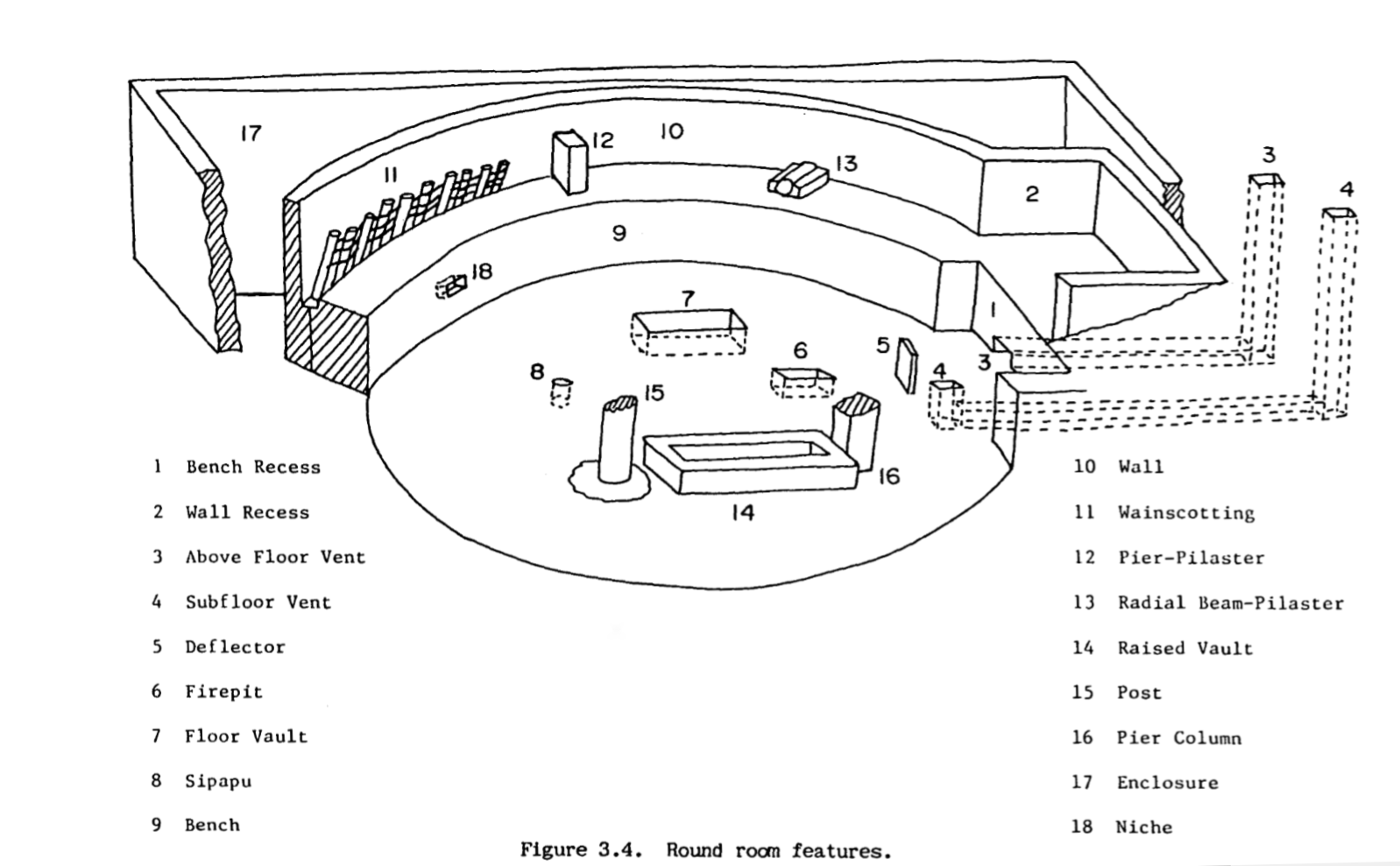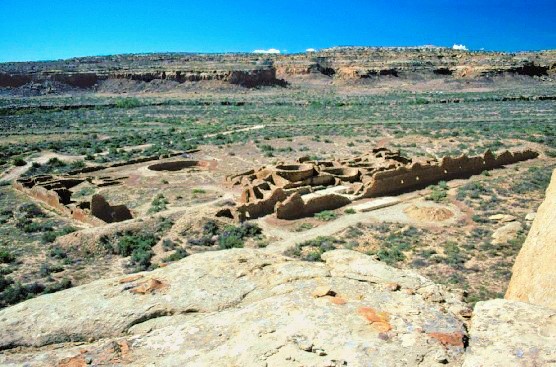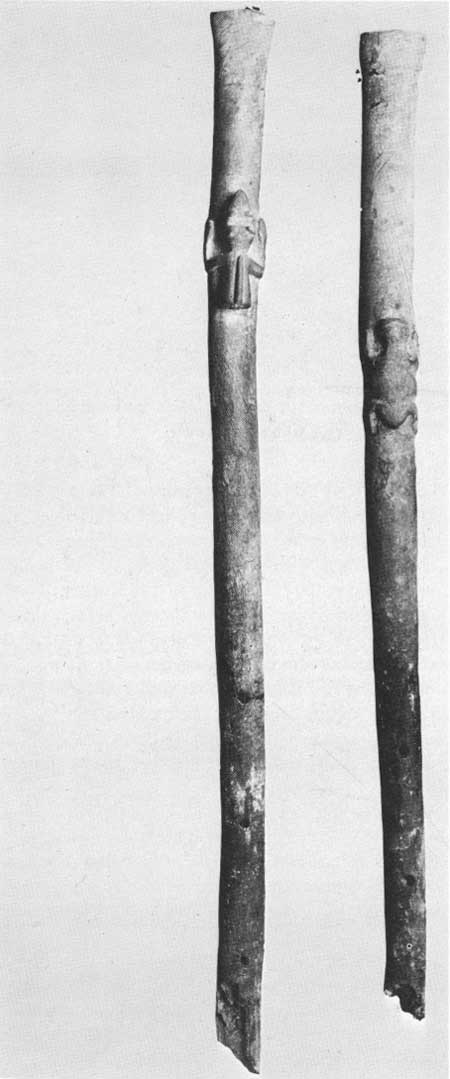|
Pueblo Bonito
Pueblo Bonito (Spanish for ''beautiful town'') is the largest and best-known great house in Chaco Culture National Historical Park, northern New Mexico. It was built by the Ancestral Puebloans who occupied the structure between AD 828 and 1126. According to the National Park Service, "Pueblo Bonito is the most thoroughly investigated and celebrated cultural site in Chaco Canyon. Planned and constructed in stages between AD 850 to AD 1150 by ancestral Puebloan peoples, this was the center of the Chacoan world." Anthropologist Brian Fagan has said that "Pueblo Bonito is an archeological icon, as famous as England's Stonehenge, Mexico's Teotihuacan, or Peru's Machu Picchu." In January 1941, a section of the canyon wall known as ''Threatening Rock'', or ''tse biyaa anii'ahi'' (leaning rock gap) in Navajo, collapsed as a result of a rock fall, destroying some of the structure's rear wall and a number of rooms. The builders of Pueblo Bonito appear to have been well aware of this ... [...More Info...] [...Related Items...] OR: [Wikipedia] [Google] [Baidu] |
San Juan County, New Mexico
San Juan County is located in the U.S. state of New Mexico. As of the 2020 census, the population was 121,661 making it the fifth-most populous county in New Mexico. Its county seat is Aztec. The county was created in 1887. San Juan County is part of the Farmington, New Mexico, Metropolitan Statistical Area. It is in the state's northwest corner and includes the New Mexico portion of the Four Corners. Geography According to the U.S. Census Bureau, the county has a total area of , of which is land and (0.5%) is water. Indian reservations (and off-reservation trust lands) comprise 63.4 percent of the county's land area: The Navajo Nation takes up 60.45% and the Ute Mountain Ute Tribe Reservation another 2.93%. The physical features include three rivers: the San Juan, Animas, and La Plata rivers; also, the Chuska Mountains and Shiprock Pinnacle to the west, volcanic structures, buttes, mesas, badlands, and fertile river valleys. Adjacent counties * Rio Arriba County - ... [...More Info...] [...Related Items...] OR: [Wikipedia] [Google] [Baidu] |
Chaco Canyon
Chaco Culture National Historical Park is a United States National Historical Park in the American Southwest hosting a concentration of pueblos. The park is located in northwestern New Mexico, between Albuquerque and Farmington, in a remote canyon cut by the Chaco Wash. Containing the most sweeping collection of ancient ruins north of Mexico, the park preserves one of the most important pre-Columbian cultural and historical areas in the United States. Between AD 900 and 1150, Chaco Canyon was a major center of culture for the Ancestral Puebloans. Chacoans quarried sandstone blocks and hauled timber from great distances, assembling fifteen major complexes that remained the largest buildings ever built in North America until the 19th century. Evidence of archaeoastronomy at Chaco has been proposed, with the "Sun Dagger" petroglyph at Fajada Butte a popular example. Many Chacoan buildings may have been aligned to capture the solar and lunar cycles, requiring generations of ast ... [...More Info...] [...Related Items...] OR: [Wikipedia] [Google] [Baidu] |
A330, Chaco Culture National Historical Park, New Mexico, USA, 2011
A33, A 33 or A-33 may refer to : * Douglas A-33, a 1941 American ground-attack fighter aircraft * A33 Excelsior British heavy tank prototype * HLA-A33, a human serotype * Samsung Galaxy A33 5G, an Android smartphone and also : * One of the ''Encyclopaedia of Chess Openings'' codes for the English Opening in chess Roads * A33 road (England) The A33 is a major road in the counties of Berkshire and Hampshire in southern England. The road currently runs in three disjoint sections. Route Reading–Basingstoke The first stretch of the A33 is a relatively new road, built as the A33 re ..., a road connecting Reading and Southampton * A33 motorway (France), a road connecting Nancy and Dombasle-sur-Meurthe * A 33 motorway (Germany), a road connecting the A 30 in the north and the A 44 in the south * A33 motorway (Italy), a road under construction connecting Asti and Cuneo * A33 motorway (Spain), a proposed road in Murcia connecting Cieza and Font de la Figuera * A33 road (Sri ... [...More Info...] [...Related Items...] OR: [Wikipedia] [Google] [Baidu] |
Core-and-veneer
Core-and-veneer, brick and rubble, wall and rubble, ashlar and rubble, and emplekton all refer to a building technique where two parallel walls are constructed and the core between them is filled with rubble or other infill, creating one thick wall. Originally, and in later poorly constructed walls, the rubble was not consolidated. Later, mortar and cement were used to consolidate the core rubble and produce sturdier construction. Modern masonry still uses core and veneer walls; however, the core is now generally concrete block instead of rubble, and moisture barriers are included. Often such walls end up as cavity walls by the inclusion of space between the external veneer and the core in order to provide for moisture and thermal control. History Greeks and Phoenicians Both the early Phoenicians and Greeks used rubble-filled masonry walls. The word ''emplekton'' was borrowed from Greek ἔμπλεκτον and originally meant "rubble" but came to apply to the construction techni ... [...More Info...] [...Related Items...] OR: [Wikipedia] [Google] [Baidu] |
Kiva
A kiva is a space used by Puebloans for rites and political meetings, many of them associated with the kachina belief system. Among the modern Hopi and most other Pueblo peoples, "kiva" means a large room that is circular and underground, and used for spiritual ceremonies. Similar subterranean rooms are found among ruins in the North-American South-West, indicating uses by the ancient peoples of the region including the ancestral Puebloans, the Mogollon, and the Hohokam. Those used by the ancient Pueblos of the Pueblo I Period and following, designated by the Pecos Classification system developed by archaeologists, were usually round and evolved from simpler pit-houses. For the Ancestral Puebloans, these rooms are believed to have had a variety of functions, including domestic residence along with social and ceremonial purposes. Evolution During the late 8th century, Mesa Verdeans started building square pit structures that archeologists call protokivas. They we ... [...More Info...] [...Related Items...] OR: [Wikipedia] [Google] [Baidu] |
PB Kivas
Pb is the chemical symbol for the chemical element lead. PB, P.B., or Pb may also refer to:ML Arts and entertainment Music * ''Paul's Boutique,'' a 1989 album by American hip-hop group the Beastie Boys * Prussian Blue, an American white nationalist pop pre-teen duo Publications * ''Performance Bikes'' (magazine), a monthly British motorcycling magazine * ''Playboy'', an American men's magazine * ''Post-Bulletin'', an American daily newspaper based in Rochester, Minnesota Television * Princess Bubblegum, a character from the 2010 animated TV series ''Adventure Time'' * ''Prison Break'', an American drama television series which originally ran from 2005 to 2009 * ''Puppy Bowl'', an American special based on the Super Bowl airing each year on Animal Planet since 2005 Anime-Manga *'' Phantom Blood'', the first story arc of ''shōnen'' manga series ''Jojo's Bizarre Adventure'' Companies and organizations * Packard Bell Corporation, an American radio manufacturer formed in 1933 th ... [...More Info...] [...Related Items...] OR: [Wikipedia] [Google] [Baidu] |
Chetro Ketl
Chetro Ketl is an Ancestral Puebloan great house and archeological site located in Chaco Culture National Historical Park, New Mexico, United States. Construction on Chetro Ketl began and was largely complete by 1075, with significant remodeling occurring in the early and mid-1110s. Following the onset of a severe drought, most Chacoans emigrated from the canyon by 1140; by 1250 Chetro Ketl's last inhabitants had vacated the structure. The great house was rediscovered in 1823 by the Mexican governor of New Mexico, José Antonio Vizcarra, and in 1849 Lieutenant James Simpson of the United States Army Corps of Engineers documented the major ruins in Chaco Canyon. Edgar L. Hewett, the director of the first archeological field school in the canyon, conducted excavations of Chetro Ketl during 1920 and 1921, and again between 1929 and 1935. Chaco scholars estimate that it required more than 500,000 man-hours, 26,000 trees, and 50 million sandstone blocks to erect Chetro ... [...More Info...] [...Related Items...] OR: [Wikipedia] [Google] [Baidu] |
Native American Flute
The Native American flute is a flute that is held in front of the player, has open finger holes, and has two chambers: one for collecting the breath of the player and a second chamber which creates sound. The player breathes into one end of the flute without the need for an embouchure. A ''block'' on the outside of the instrument directs the player's breath from the first chamber—called the slow air chamber—into the second chamber—called the sound chamber. The design of a ''sound hole'' at the proximal end of the sound chamber causes air from the player's breath to vibrate. This vibration causes a steady resonance of air pressure in the sound chamber that creates sound. Native American flutes comprise a wide range of designs, sizes, and variations—far more varied than most other classes of woodwind instruments. Names The instrument is known by many names. Some of the reasons for the variety of names include: the varied uses of the instrument (e.g. courting), the wid ... [...More Info...] [...Related Items...] OR: [Wikipedia] [Google] [Baidu] |
Anasazi Flute
The Anasazi flute is the name of a prehistoric end-blown flute replicated today from findings at a massive cave in Prayer Rock Valley in Arizona, United States by an archaeological expedition led by Earl H. Morris in 1931. The team excavated 15 caves and the largest among them had 16 dwellings and many artifacts including several wooden flutes, which gave the site its name, the Broken Flute Cave. The flutes found in the cave were dated between 620 and 670 AD. They were all made of Box elder, have six finger holes and are end-blown. It is similar in many respects to a Hopi flute, which has only five finger holes. A detailed analysis using radiocarbon dating techniques was published in 2007. The analysis included one item from a burial pit in the Broken Flute Cave. The dating placed the artifact in the range 599–769 AD. The Anasazi flute has in recent years been reproduced and restored to the catalog of World flutes. While difficult to play in many respects, it has a rich, ... [...More Info...] [...Related Items...] OR: [Wikipedia] [Google] [Baidu] |
Frederick E
Frederick may refer to: People * Frederick (given name), the name Nobility Anhalt-Harzgerode * Frederick, Prince of Anhalt-Harzgerode (1613–1670) Austria * Frederick I, Duke of Austria (Babenberg), Duke of Austria from 1195 to 1198 * Frederick II, Duke of Austria (1219–1246), last Duke of Austria from the Babenberg dynasty * Frederick the Fair (Frederick I of Austria (Habsburg), 1286–1330), Duke of Austria and King of the Romans Baden * Frederick I, Grand Duke of Baden (1826–1907), Grand Duke of Baden * Frederick II, Grand Duke of Baden (1857–1928), Grand Duke of Baden Bohemia * Frederick, Duke of Bohemia (died 1189), Duke of Olomouc and Bohemia Britain * Frederick, Prince of Wales (1707–1751), eldest son of King George II of Great Britain Brandenburg/Prussia * Frederick I, Elector of Brandenburg (1371–1440), also known as Frederick VI, Burgrave of Nuremberg * Frederick II, Elector of Brandenburg (1413–1470), Margrave of Brandenburg * Frederick William, ... [...More Info...] [...Related Items...] OR: [Wikipedia] [Google] [Baidu] |





